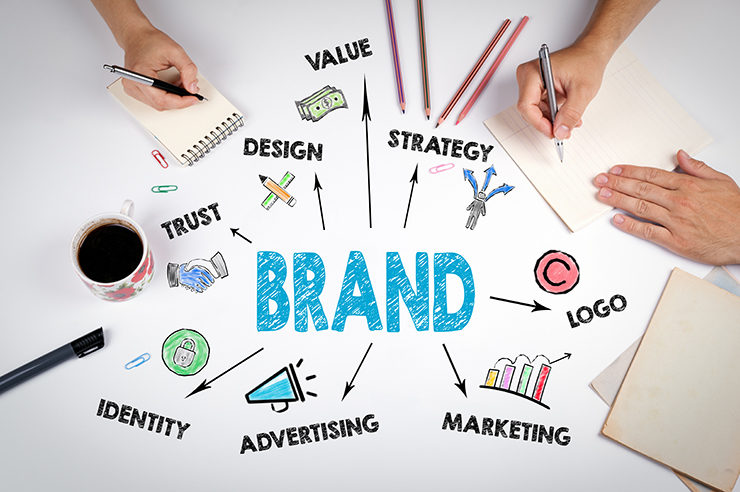
Essential Guide To How To Do Branding For A Business Or Startup For Beginners

Essential Guide To How To Do Branding For A Business Or Startup For Beginners
If you’re starting a new business or startup, knowing how to do and how to carry out branding is critical. You need to make your mark in the right way and get people excited enough about your company that they want to invest in it. But in this day and age a well-executed design strategy can be as crucial as your product or service. Follow this introduction of this guide if you want help to create an effective brand for your business or idea.
What is Branding?
branding is the term noun for the creation of a name, term, design, symbol or other feature that identifies a product or service and distinguishes it from those of others.
Branding can help create a distinct and memorable connection between a company and its customers, making them more likely to return and recommend your business.
after all, if you can’t attract customers, you can’t grow your business. On the other hand, if you don’t have a clear message to share with the world, you may struggle to stand out from the competition. Here are some essential steps for branding your business:
- Discover who your customer is : This means learning as much about them as possible, including their demographics and interests. Once you know who they are and what they want, you can begin tailoring your messaging specifically to them.
- Develop a unique selling proposition (USP) : This is the unique thing about your company that sets it apart from its competitors. What benefit do customers get by choosing your product or service? How is it better than anything else on the market? articulate this in a concise but powerful way.
What type of branding works best for a startup or business?
There are a few different types of branding that work well for startups and businesses, but which one is best for your business?
First, some businesses might prefer an Applied Mythology approach to branding, where their identity is based on a story or concept that visitors can understand. Other businesses might opt for something more literal, like using the colors blue and yellow to represent the company’s name.
Ultimately, it’s important to choose a branding strategy that works well for your business. For example, if your business focuses on technology products, using tech-related terms like “revolutionary” or “innovative” might be a good idea. If you’re in the health and fitness industry, using terms like “fit bod” or “jacked up metabolism” might be more effective.
No matter what type of branding strategy you choose, make sure it’s consistent across all aspects of your marketing efforts (including website design, social media profiles, and product descriptions). inconsistencies can confuse customers and damage your brand’s credibility.
What’s the difference between a logo and a brand?
Logo : A logo is the graphic image that represents your business or startup. It’s often used on marketing materials and can be a simple design, or a more elaborate one. A brand, on the other hand, is much more complex and encompasses everything from your company’s name to its values.
There are a few things to keep in mind when it comes to designing a logo for your business or startup.First and foremost, always make sure that your logo is easily recognizable and fits with the overall branding of your company.
It should also be modern and relevant, so that it looks good in today’s digital world.Once you’ve settled on a logo, you’ll need to determine what kind of branding strategy best suits your business.
Whether you want to go with a single identity for all of your products and services or focus on different areas like marketing, packaging, and website design, there’s an option for you.
Once you have a finalized logo and branding strategy, make sure to put it into practice across all your marketing materials—from social media profiles to brochures and even email signatures! Building a consistent brand will help attract new customers and lead your business forward into the future.”
Learn New Skills Today

Why branding is important ?
Branding is the manifestation of a company or product’s name, idea, or image in the minds of consumers. Branding creates an emotional connection between a business or product and its customers. It fosters customer loyalty and increased sales.
Knowing how to do branding for your business can be incredibly beneficial. Here are six reasons why branding is so important:
- Establishing trust and credibility with your customers. By consistently reinforcing the brand identity and mission through marketing materials, you can cultivate a level of customer trust that is difficult to replicate. This will result in repeat business and greater word-of-mouth referrals.
- Creating differentiation from your competition. The key to success with branding is to craft a unique message that stands out from the competition. By creating a unique Nursey Place identity, you’ll be able to set yourself apart from other pediatric clinics and attract new customers who appreciate your unique selling proposition (USP).
- Charging a premium for your products or services. When customers perceive that investing in your product or service offers tangible returns, they are much more likely to do so. By developing a clear value proposition, you can help customers understand what

How to do branding
There is no one way to do branding for a business or startup, as the strategy and approach will vary depending on the type of business or startup. However, there are some key principles that can be followed when doing branding for a business or startup.
- Come up with a clear brand identity. In order to create a strong brand identity for your business or startup, it is important to come up with a clear message that you want to communicate to your customers and partners. This may involve developing a name and visual brand style that stands out from the competition. You can also use your brand identity to champion specific values or areas of your business.
For example, if you run a health food store, you might want to promote healthy eating habits as part of your brand identity. - Control the communications channels that relate to your brand. Once you have developed a clear brand identity and communicated your message through communications channels such as logo design, marketing materials, website design, and social media content, it is important to control those channels so that they support your overall strategy. This means ensuring that all elements of your marketing communication are consistent with each other and promoting content that furthers
Making Your Brand Visible
Creating a strong and recognizable brand is essential for any business or startup. There are a few things you can do to create a successful brand.
- Develop a name that reflects who you are and what you do.
- Make sure your web and marketing materials are consistent with your name and message.
- Be articulate and concise when communicating your brand message.
- Keep up with trends and make sure your branding is updated regularly.
- Reward loyal customers and followers with unique perks or discounts.
- Be prepared to defend your brand whenever necessary.
- Take care of your image – avoid negative publicity and stay top of mind with consumers.
How To Promote Your Brand
When it comes to promoting your business or startup, understanding the basics of branding is essential. A well-executed branding campaign will help you build customer trust and interest, while also attracting new customers and investors. Here are five tips for doing branding right:

- Make it personal: When developing a brand, make sure to focus on what makes your company unique. Be sure to position your company in a positive light by highlighting the things you stand for.
- Find a visual identity: Your branding should include a visual identity that represents your company perfectly. This can be achieved by using appropriate imagery, colors, and text styles.
- Build a strong online presence: When it comes to your online presence, make sure to invest in strong branding strategies such as content marketing and online advertising. This will help you attract more customers and investors.
- Keep it consistent: One of the most important aspects of good branding is consistency across different platforms and channels. Make sure all material related to your brand looks and feels consistent.
- Be prepared for setbacks: Always be prepared for potential setbacks during your branding campaign. Be aware of any potential problems early on so that you can address them
How much do you need to spending on branding?
There is no definitive answer to this question as everything will vary depending on the size, scope and target audience of your business or startup.
However, generally speaking, you will need to spend between $2,000 and $10,000 on branding if you want to create a professional and effective presence online. Here are some tips to help you get started:
-First, decide what kind of branding you want for your business or startup. There are many different types of branding out there, including corporate branding (for businesses with a national or international scope), product/service branding (for businesses with specific offerings), competitive branding (for businesses looking to differentiate themselves from their rivals) and niche branding (for businesses with a specific focus).
Once you have identified the type of branding that is right for your business, begin looking for an appropriate logo and tagline.
-Second, budget for marketing expenses associated with your branding efforts. This includes things like design costs (for logos and tags), website hosting fees, banner ads on Google and other search engines, social media marketing campaigns, email marketing services and more.
-Finally, be patient while your business or startup brand builds momentum – it can take months or even years
Legal aspects of branding like trademark,copyright
When starting your own business, one of the first things you need to do is come up with a brand. However, before you can even think about branding, you need to make sure that your business is legally compliant.
This means understanding trademark and copyright law, as well as the difference between using trademarks and COPYRIGHT. In this article, we’ll talk about each of these concepts in detail, and give you a step-by-step guide on how to do branding for a business or startup. What Is A Trademark?
Often called a “mark” or “brand,” a trademark is the name, symbol, word or design that distinguishes your company (or product) from those of others in almost all ways. Your trademark is the evidence that distinguishes you from your competitors and goes beyond just being a logo, slogan, or tagline.
Whether you consider yourself an artist, craftsperson, architect or corporation founder, if somebody makes any attempt to directly take advantage of what they know about your business as part of some other endeavor in order to benefit themselves at your expense with trade dress or dress alike….think copyright infringement.
Sometimes things such as building designs need protection under both trademark and copyright law. You may have seen invent ors concepts for electronic products on the internet before.
If you couldn’t build these exact same things for yourself to save your life, you can come to us with what you know and we have no trouble making every detail exactly as shown with more than enough time to scale up production.
Intellectual property can give this hardworking inventor just what she needs so that she may be compensated, instead of having to lay her mental labors bare, only to be literally robbed better than financially raped by ne’er-do-wells that have no brain in their skulls.